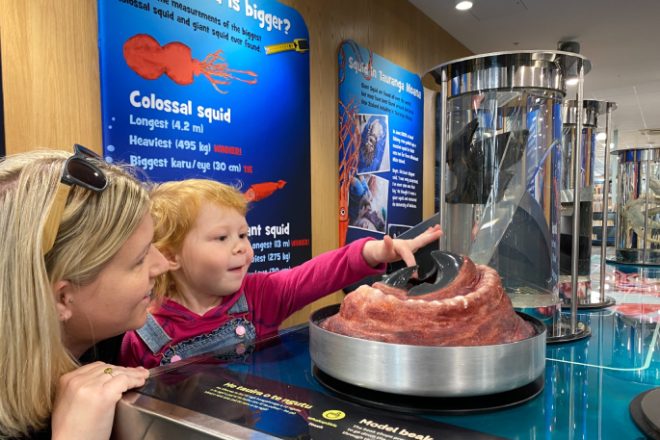‘거대한 오징어’: 별난 특징!더 뉴 티푸아: 나 와앙가 웨리웨리! ‘전시회는 현재 테 아오 마라마 – 타우랑가 도서관에서 6월 27일 목요일까지 일반에 공개된다.타우랑가 시립 도서관의 크리에이티브 및 마케팅 코디네이터인 대니얼 피터슨 (Daniel Petersen) 은 타우랑가 시립 도서관, 타우랑가 박물관, 테파파가 최초로 협업한 결과물로 눈길을 사로잡는 이번 전시회라고 한다.
전시회 방문객들은 눈 모양의 렌즈, 촉수 조각, 작은 오징어 등 거대한 오징어의 일부를 전시하는 인터랙티브 테이블을 둘러볼 수 있습니다.거대한 오징어의 촉수 갈고리와 부리를 회전시키는 모형도 있어 방문객들은 이 거대한 오징어의 크기와 비교해 볼 수 있습니다.
거대한 오징어는 극한의 깊이와 얼어붙은 물에 서식하는 신비한 생물이기 때문에 연구하기가 어렵습니다.거대한 오징어에 대한 최초의 과학적 보고는 향유고래의 뱃속에서 일부가 발견된 1925년에야 이루어졌습니다.그 이후로 성체 거대 오징어는 몇 마리만 기록되었으며, 완전히 발견된 것은 4마리뿐입니다.
채집된 표본의 대부분은 고래, 상어, 알바트로스와 같이 먹이를 찾아 헤매는 새의 뱃속에서 발견되는 작은 부위입니다.거대한 크기와 이상한 특징에도 불구하고 이들 생물에 대한 정보가 부족하다는 점이 특히 흥미롭습니다.거대한 오징어는 수 세대 동안 전 세계 사람들의 호기심을 사로잡았습니다.
다니엘은 테파파에서 대여한 놀라운 표본들 덕분에 거대한 오징어의 일부를 가까이서 볼 수 있는 이 특별한 기회를 놓치지 말라고 모두에게 권합니다.






























































